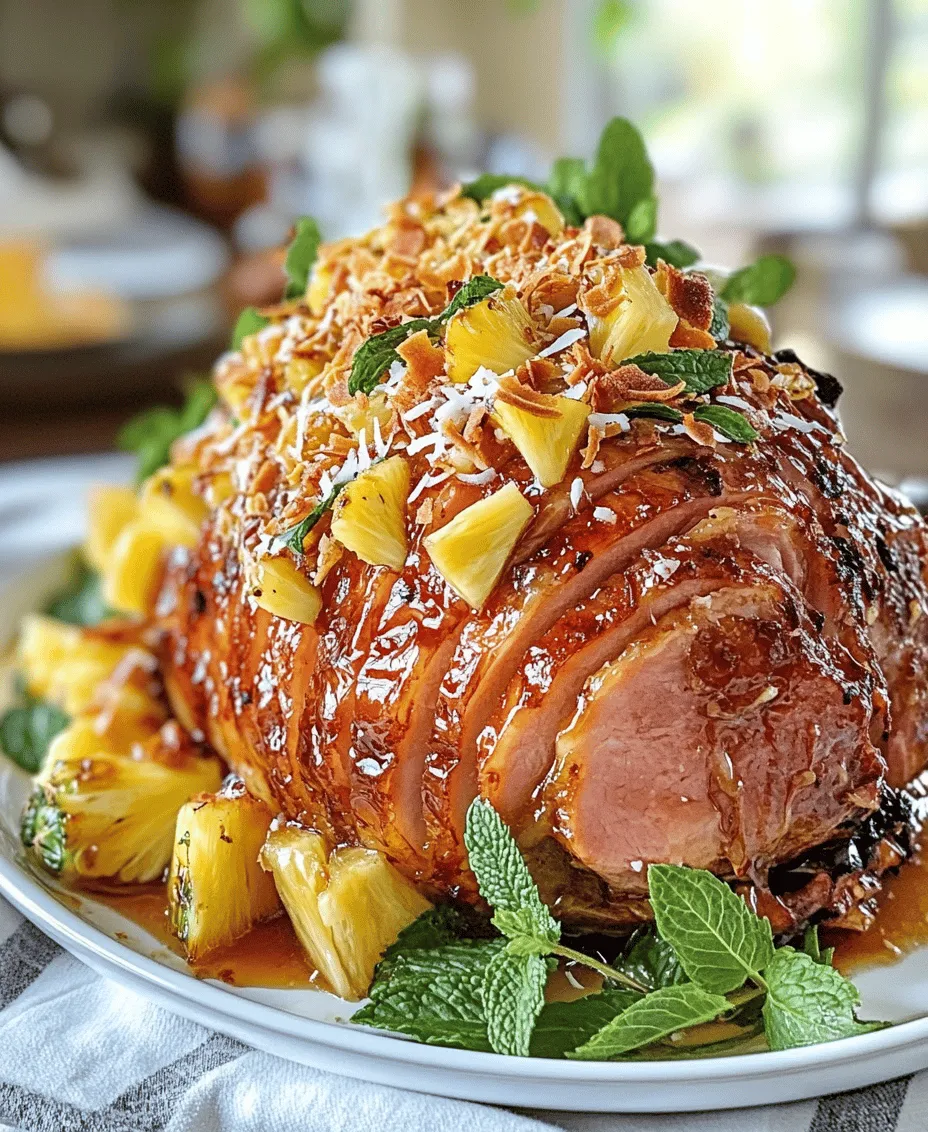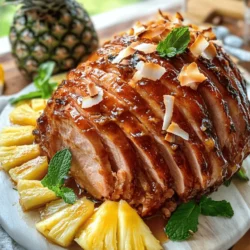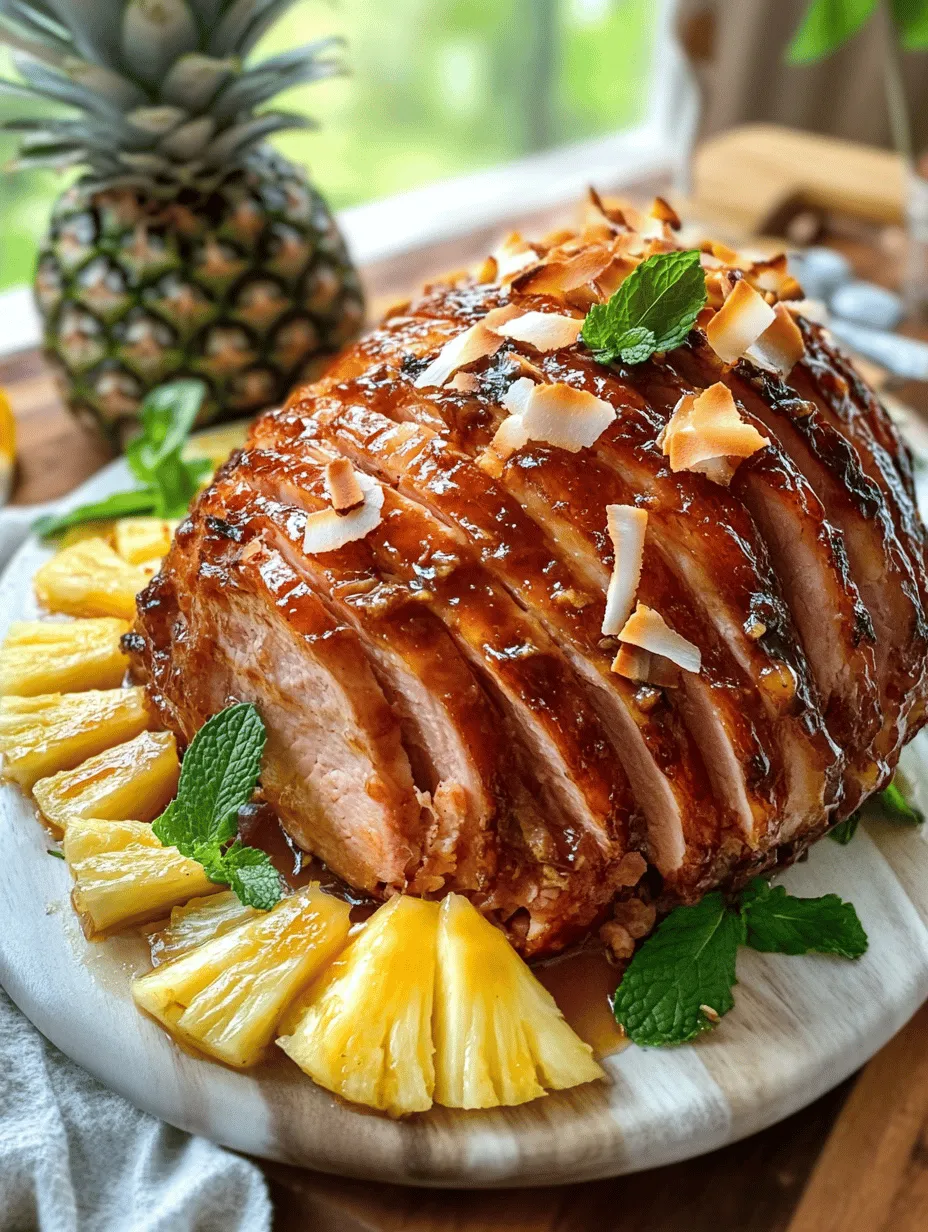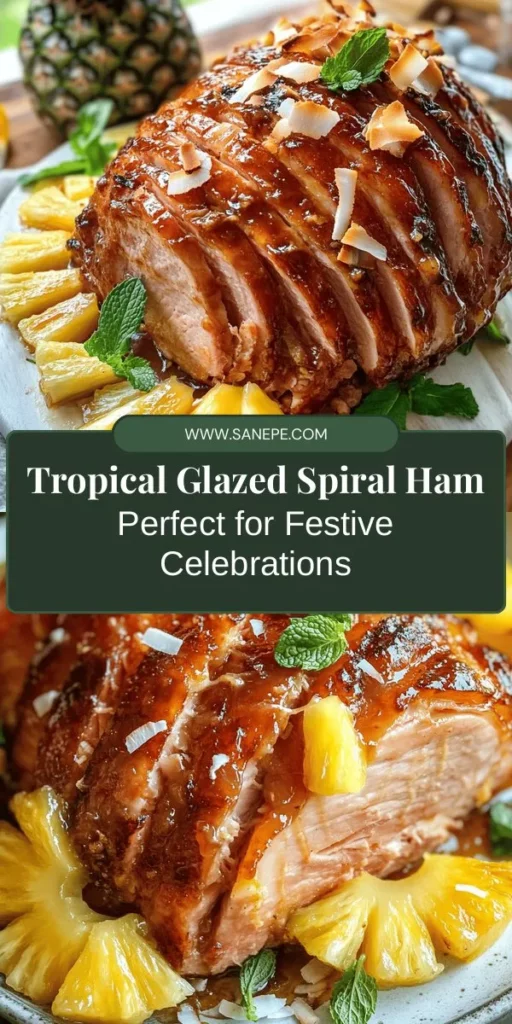Introduction
There’s something undeniably alluring about a beautifully glazed spiral ham, particularly when it’s infused with tropical flavors that whisk you away to a sun-soaked paradise. The Tropical Glazed Spiral Ham is not just a centerpiece; it’s a celebration on a platter, making it the perfect dish for gatherings, holiday feasts, and special occasions. Imagine the enticing aroma wafting through your home as this succulent ham slowly bakes to perfection, its sweet and savory glaze enveloping every inch of the tender meat.
This dish stands out not only for its striking appearance but also for its vibrant flavors. A harmonious blend of brown sugar, honey, pineapple juice, and coconut milk creates a glaze that’s both sweet and tangy, while a medley of spices adds depth and warmth. Each slice presents a rainbow of tastes, making it an unforgettable experience for your guests. Whether you’re hosting a festive dinner or a casual family get-together, this Tropical Glazed Spiral Ham will undoubtedly elevate your meal and leave everyone asking for seconds.
Understanding Spiral Ham
Before diving into the specifics of our tropical glaze, it’s essential to understand what spiral ham is and why it has become a beloved choice for holiday meals. Spiral ham is a pre-cooked ham that has been cut in a spiral shape, making it incredibly easy to serve. The spiral cuts allow for uniform slices, ensuring that each piece is tender and flavorful, perfect for feeding a crowd.
One of the primary benefits of using spiral-cut ham is its convenience. Because it comes pre-cooked, the preparation process is significantly simplified. You won’t need to spend hours cooking the ham from scratch, allowing you to focus on creating delicious sides or desserts to complement your main dish. Additionally, the spiral cuts enable the glaze to seep into the meat, creating an exceptionally moist and flavorful ham that’s hard to resist.
From a nutritional standpoint, spiral ham can be a relatively lean source of protein, especially when you choose lower-sodium options. However, it’s important to be mindful of portion sizes, as ham can be high in sodium and saturated fat. With the right cooking techniques and mindful ingredient selection, you can create a dish that satisfies both your taste buds and your health goals.
Key Ingredients for Tropical Glazed Spiral Ham
Now that we’ve established the allure of spiral ham let’s dive into the key ingredients that make this Tropical Glazed Spiral Ham recipe a standout:
– Fully Cooked Spiral-Cut Ham: The star of the show, a fully cooked spiral ham serves as the perfect canvas for our tropical glaze. Look for a high-quality ham that is moist and flavorful, as the quality of the meat will significantly impact the final dish.
– Brown Sugar and Honey: These two ingredients provide the sweetness that balances the savory notes of the ham. Brown sugar contributes to caramelization, yielding a beautifully glossy finish, while honey adds a floral sweetness that enhances the tropical profile.
– Pineapple Juice and Coconut Milk: The essence of the tropics is captured in these two ingredients. Pineapple juice provides a bright, fruity acidity that complements the sweetness of the glaze, while coconut milk lends a rich, creamy texture that elevates the overall flavor.
– Dijon Mustard, Ginger, Cinnamon, Cloves, and Cayenne Pepper: This blend of spices adds complexity and warmth to the glaze. Dijon mustard introduces a tangy bite, while ginger and cinnamon bring a hint of warmth. Cloves add an aromatic depth, and a dash of cayenne pepper gives the glaze a subtle kick, balancing out the sweetness.
– Importance of Ingredient Quality: When it comes to cooking, ingredient quality is paramount. Fresh, high-quality ingredients not only enhance the flavors but also contribute to the overall presentation of the dish. Opt for organic or locally sourced items when possible, as they often yield better taste and texture.
Step-by-Step Preparation Guide
With our ingredients in hand, let’s walk through the essential preparatory steps to ensure your Tropical Glazed Spiral Ham is a resounding success.
Preheating the Oven
Before you start preparing your ham, it’s crucial to preheat your oven to the appropriate temperature. For this recipe, set your oven to 325°F (163°C). Preheating is essential as it ensures even cooking and helps the glaze to caramelize beautifully. While the oven is warming up, you can start preparing the ham.
Preparing the Ham
When it comes to handling your spiral-cut ham, there are a few important techniques to consider:
1. Unwrapping the Ham: Begin by carefully unwrapping the ham from its packaging. If there is a plastic cap over the bone, remove it as well. This will help the glaze penetrate and flavor the meat more effectively.
2. Scoring the Surface: To maximize the flavor infusion from the glaze, score the surface of the ham in a diamond pattern. Use a sharp knife to make shallow cuts about 1 inch apart, being cautious not to cut too deep into the meat. This technique not only allows the glaze to seep in but also creates an attractive presentation.
3. Placing the Ham in a Roasting Pan: Position the ham cut side down in a large roasting pan. This helps to keep the meat moist during cooking, as the juices will gather in the bottom of the pan. If you have a rack, you can place the ham on it to facilitate even cooking.
4. Covering the Ham: To retain moisture, cover the ham loosely with aluminum foil. This step will help to prevent the exterior from drying out while allowing the glaze to develop a beautiful color and flavor.
Now that your ham is prepared and the oven is preheated, you’re ready to move on to the next stages of creating the tropical glaze and baking the ham to juicy perfection. This exciting fusion of flavors will transform your dinner table into a tropical paradise, making every bite a celebration. Stay tuned for the next part where we will delve into the process of creating the glaze and the final baking instructions to ensure your Tropical Glazed Spiral Ham shines at your next gathering.

Crafting the Tropical Glaze: Cooking Methods and Tips for Consistency
Creating the perfect tropical glaze for your spiral ham is essential to infuse it with flavor and ensure a beautiful finish. Start by selecting your base ingredients, which typically include pineapple juice, brown sugar, honey, coconut milk, and spices like ginger and cinnamon. To make the glaze, combine these ingredients in a saucepan over medium heat. Stir continuously until the sugar dissolves and the mixture begins to bubble, which usually takes about 5 to 7 minutes.
For consistency, it’s important to simmer the glaze gently, allowing it to reduce and thicken. You want a syrupy texture that clings to the ham without being overly runny. If the glaze is too thick, adding a splash of water can help achieve the desired consistency. Conversely, if it’s too thin, continue simmering until it thickens to your liking. Remember to taste and adjust the sweetness or spices as needed, ensuring a balanced flavor that complements the ham beautifully.
Glazing Techniques: How to Effectively Apply the Glaze for Maximum Flavor
Once your glaze is ready, the next step is to effectively apply it to the ham for maximum flavor. Begin by preheating your oven to 325°F (163°C). Before applying the glaze, make sure the ham is properly scored. This involves making shallow cuts in a diamond pattern across the surface of the ham. Not only does this enhance the presentation, but it also allows the glaze to penetrate deeper into the meat, ensuring that each bite is flavorful.
Using a basting brush or a ladle, generously apply the glaze all over the ham, ensuring that it seeps into the scored sections. A common technique is to glaze the ham every 20 to 30 minutes during the baking process. This not only builds layers of flavor but also creates a sticky, caramelized crust that enhances the overall presentation. Don’t be afraid to be liberal with the glaze; the more, the merrier!
Baking Process: Timing and Temperature for Optimal Results
Baking your tropical glazed spiral ham requires attention to timing and temperature to achieve optimal results. After glazing, place the ham in a roasting pan, cut side down. A general rule of thumb for cooking time is about 10 to 15 minutes per pound. For example, if you have a 10-pound ham, you’ll want to bake it for approximately 1.5 to 2.5 hours.
To ensure even cooking, it’s advisable to cover the ham loosely with aluminum foil for the first half of the baking time. This helps to retain moisture and prevents the glaze from burning. After the first hour, remove the foil to allow the glaze to caramelize and develop a rich flavor. Keep an eye on the internal temperature, which should reach 140°F (60°C) for pre-cooked ham. Using a meat thermometer is the best way to ensure that your ham is heated adequately without overcooking.
Final Glaze Application: Importance of the Last Few Minutes of Baking
The last few minutes of baking are crucial for achieving that perfect, glossy finish on your tropical glazed spiral ham. Once your ham reaches the desired internal temperature, increase the oven temperature to 400°F (204°C) for the final 10 to 15 minutes of cooking. This step will give the glaze a beautiful caramelized appearance and enhance its flavor.
During this time, it’s beneficial to apply a final layer of glaze. Use a basting brush to coat the ham once more and let it bake uncovered. This caramelization process enriches the flavors, creating a stunningly beautiful ham that will be the centerpiece of your table. Keep a close watch to prevent burning, but don’t be afraid to let it get a little bubbly and darker for that stunning visual appeal.
Serving Suggestions
Presentation Ideas for a Stunning Serving Platter
When it comes to serving your Tropical Glazed Spiral Ham, presentation is key. Start by carefully transferring the ham to a large serving platter. You can garnish the platter with fresh pineapple slices, mango wedges, and sprigs of mint or parsley for a vibrant look. Consider using a decorative cutting board or a wooden platter for a rustic touch. Arranging the slices in a fan shape not only makes for an inviting display but also makes it easier for guests to serve themselves.
For an added touch, consider creating a tropical theme by incorporating colorful fruit salads or tropical flowers around the ham. This not only enhances the visual appeal but also complements the flavors of the dish, making your presentation both festive and inviting.
Complementary Side Dishes That Pair Well with Tropical Glazed Ham
To create a well-rounded meal, pairing your tropical glazed ham with complementary side dishes is essential. Here are some excellent options:
1. Coconut Rice: The subtle sweetness of coconut rice pairs beautifully with the tropical flavors of the ham.
2. Grilled Asparagus: Lightly seasoned and grilled asparagus adds a fresh crunch that balances the richness of the ham.
3. Savory Sweet Potato Mash: The natural sweetness of sweet potatoes harmonizes with the glaze, making it a perfect companion.
4. Tropical Fruit Salad: A refreshing mix of pineapple, mango, and kiwi provides a bright contrast to the savory ham.
5. Coleslaw: A tangy coleslaw can cut through the sweetness of the glaze, offering a delightful crunch.
Beverage Pairings to Enhance the Meal Experience
Selecting the right beverages can elevate your tropical glazed ham experience. Here are some recommendations:
1. Pineapple Juice Cocktails: A cocktail made with pineapple juice, coconut rum, and a splash of soda can complement the tropical flavors perfectly.
2. Light White Wines: Wines such as Sauvignon Blanc or a dry Riesling can refresh the palate while enhancing the dish’s flavors.
3. Sparkling Water with Citrus: For a non-alcoholic option, sparkling water infused with lime or lemon adds a refreshing touch.
4. Iced Tea with Mint: A light mint iced tea offers a refreshing counterpoint to the sweetness of the ham.
The Cultural Significance of Ham in Celebrations
Historical Context of Ham as a Festive Dish
Ham has long been a staple in celebratory meals across various cultures. In many Western countries, ham is traditionally served during holidays such as Christmas and Easter. The curing process, which can take weeks, imbues the meat with rich flavors and creates a dish that symbolizes abundance and festivity. In some cultures, the act of preparing a large ham for family gatherings represents hospitality and the importance of sharing food with loved ones.
The spiral cut ham, specifically, has gained popularity due to its ease of serving and presentation. This method of preparation not only allows for even cooking but also makes it simple for guests to help themselves, embodying the spirit of communal dining.
How Tropical Flavors Reflect Cultural Influences in Cuisine
As culinary traditions evolve, the incorporation of tropical flavors into ham dishes reflects the blending of cultures. Many regions with access to tropical fruits, such as pineapples and coconuts, have adapted traditional ham recipes to include these ingredients, creating a unique fusion of flavors. This trend showcases how food evolves and adapts, drawing from various influences to celebrate local ingredients and cultural heritage.
Celebrating with Food: The Role of Ham in Gatherings and Traditions
Food often plays a central role in celebrations and gatherings, serving as a conduit for connection and joy. Ham, particularly in its glazed form, has a way of bringing people together, marking special occasions with its rich, savory flavor. Whether it’s a holiday feast, a family reunion, or a summer barbecue, serving ham signifies joy, abundance, and togetherness, creating lasting memories around the dining table.
Health Considerations and Alternatives
Discussing Dietary Preferences (Gluten-Free, Low-Sugar Options)
In today’s health-conscious world, offering dietary alternatives is essential. Fortunately, this Tropical Glazed Spiral Ham recipe can easily be adapted for various dietary preferences. For those seeking gluten-free options, ensure that all ingredients, such as soy sauce or marinades, are labeled gluten-free. Additionally, using natural sweeteners like agave syrup or maple syrup can cater to low-sugar diets without compromising flavor.
Suggestions for Reducing Sugar While Maintaining Flavor
While the traditional glaze is deliciously sweet, it can be modified to suit those looking to reduce sugar intake. Try substituting half of the brown sugar with unsweetened applesauce or pureed dates to maintain sweetness while lowering refined sugar content. Additionally, enhancing the glaze with spices like cinnamon or nutmeg can add depth and flavor without extra sugar.
Alternative Cooking Methods (Slow Cooker vs. Oven)
If you prefer a hands-off approach, consider cooking your ham in a slow cooker. This method allows for a tender and succulent ham without the need for constant monitoring. Simply coat the ham with the glaze, place it in the slow cooker, and cook on low for 6 to 8 hours. The slow cooking process allows flavors to develop beautifully while maintaining moisture, making it an excellent alternative to traditional oven baking.
Conclusion
In summary, the Tropical Glazed Spiral Ham recipe is more than just a dish; it’s an experience that brings families and friends together to celebrate life’s special moments. The combination of a beautifully glazed ham with tropical flavors creates a centerpiece that’s sure to impress and delight your guests. Whether you’re hosting a holiday gathering or a casual family dinner, this recipe is a perfect choice to incorporate into your culinary repertoire.
As you prepare to try this flavorful dish, take a moment to reflect on the traditions and gatherings that surround it. Embrace the opportunity to share this delicious ham with your loved ones, creating new memories while honoring the rich history of ham in celebrations. We encourage you to make this Tropical Glazed Spiral Ham your own by experimenting with flavors and presentations, and don’t forget to share your culinary journey with family and friends. Enjoy the process, and happy cooking!


